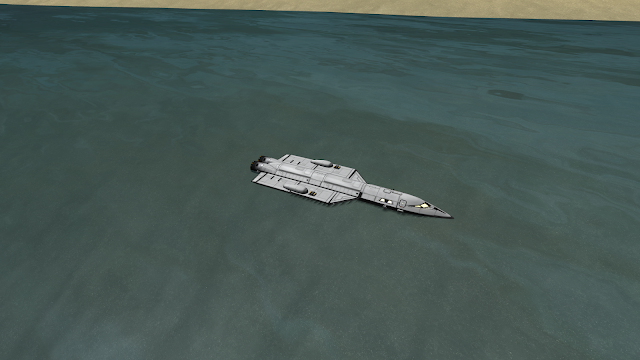The colony ships are built in orbit, with each part launched separately on the same heavy-lift boosters that sent up the Robotic Fleet. The core of each ship, around which the rest of the ship is built, is a Passenger Module:
 |
| The Passenger Module |
The Passenger Module has room for 18 Kerbals (half the crew of each ship), with two main living compartments on each end, a central stack of general purpose seating, and two observation domes. It's meant to be the "comfortable" portion of the ship, to make the multi-year journey more bearable than would be possible in a lander cockpit. Not that Kerbals really care.
One of the main quality of life considerations for the colony ships is the ability to spin to generate artificial gravity in some of the living quarters. For this reason, the rest of the ship is built along an axis passing through the center of the passenger module. Forward, the next part is the Docking Module:
 |
| The Docking Module |
While it has space for another six Kerbals, the Docking Module is more of a working space than a living space. Since it's on the central axis, there's no artificial gravity. But it has a large science lab and common area for the crew. Most importantly, it serves as the docking interface for the Space Planes, which shuttle crew to and from the colony ships.
 |
| The Space Planes |
The Space Planes are really the key to this entire mission, providing a way to get hundreds of Kerbals down to Laythe without having to exactly target flat landing sites from orbit. I tweaked and tested the design to the point where getting to orbit, docking with a colony ship, and returning to Kerbin for a runway landing was utterly routine. Each colony ship required four Space Plane round-trips and two one-way trips to fully crew. The two one-ways go with the ship to Laythe, where they will be used to ferry Kerbals down to the surface.
The back-to-back docking configuration for the Space Planes minimizes the moment of inertia along the spin axis. The two planes have to be exactly symmetric, so each interfaces with two medium-size docking ports for alignment. It is possible, with careful flying, to get both ports to engage at the same time. In addition to enforcing symmetry, this makes the final structure much more rigid. Finding parts that are exactly the right spacing on both sides to make this possible was the trickiest part of the design.
I could write an entire post about the Space Plane design, but I think I'll just post some pictures and videos of it kicking ass instead:
The last picture has a story that goes with it: For some reason, after dozens of clean flights, I botched a take-off and slammed back into the KSC runway with the gear still down, breaking off both wings, the outer engines and fuel tanks, the vertical stabilizers, and all but the two inner horizontal control surfaces. The fraction of a plane that was left was somehow still able to gain altitude, do a wide 180º turn, and make a water landing just off shore.
Anyway, back to the colony ships. Behind the Passenger Module is a truss structure I just call The Node:
 |
| The Node |
This is the lightest and simplest part of the colony ship, primarily serving as a connector between the crew stack and the propulsion. It also carries the large solar panels, some battery storage, extra reaction control systems, and side ports for docking other modules, such as for refueling. Altogether a small but important building block.
To push all this, three Propulsion Modules are launched separately and docked to the back of the Node. These are the full four-engine versions of the propulsion modules used for the Robotic Fleet.
 |
| The Propulsion Modules |
With 12 engines in total, the colony ships actually have a higher thrust-to-weight ratio than the robotic landers. The entire colony ship, including the two Space Planes, comes in at just under 300 tons and has a fully-fueled Delta-V of about 4400m/s, which should be enough to get to Laythe orbit with just a tiny bit of help from gravity assists off Tylo (or Laythe itself).
The process of building a single colony ship takes 13 separate launches: six for assembly, six crew shuttles (including two permanent ones), and one refueling run. (While the propulsion modules get to orbit fully-fueled, the total Delta-V counts on topping off the two Space Planes.) It's without a doubt the most ambitious in-orbit construction project I've attempted in KSP.
Oh, and I built 10 of these for Launch Window #2. That's about 3,000 tons of hardware, including 20 Space Planes and 360 Kerbals, on the way to Laythe.
196 Days Remain
I had intended for the second launch window to be the last ships out, but my arbitrary deadline of Year 3, Day 0 for the destruction of Kerbin leaves some time to send up a few more. They'll have to wait for the third launch window, possibly in the relative safety of a Minmus orbit, but I can think of a few extra pieces of hardware that would be useful to the colony.





